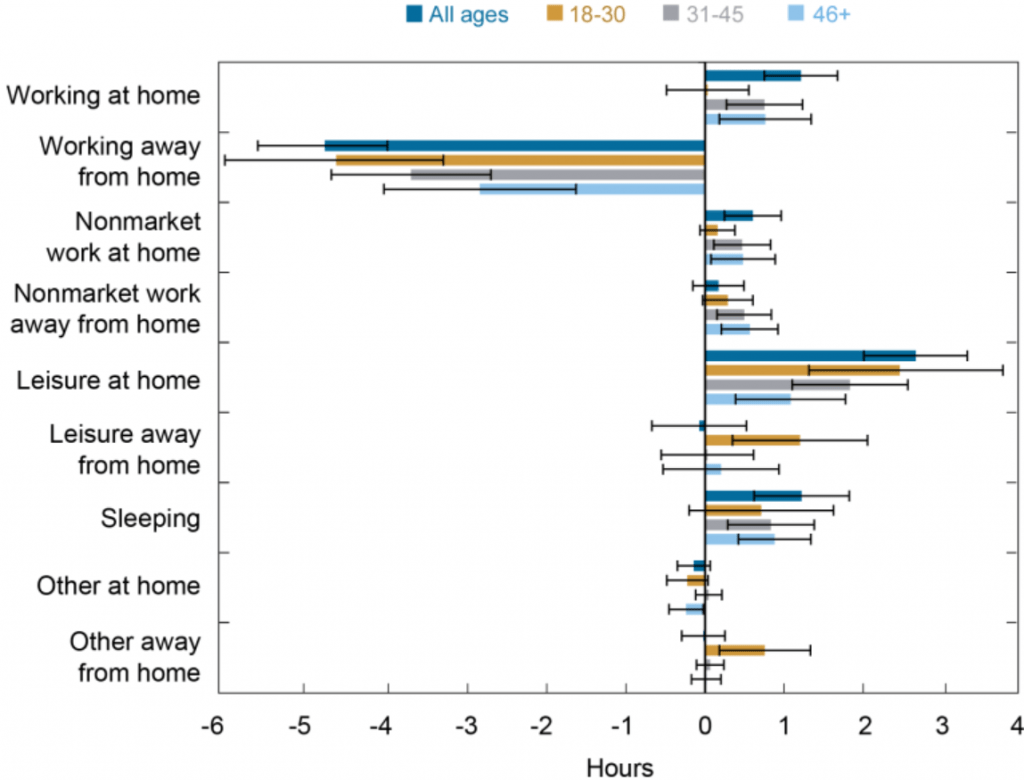A recent survey from the U.S. Bureau Of Labor Statistics American Time Use Survey (ATUS) found that employed individuals are allocating their saved commute time toward leisure activities and sleeping, while reducing overall work hours. The data also reveals the increasing number of Americans who are taking advantage of remote-work benefits, which is good news for workers and their families.
According to the latest figures, nearly 60 million Americans who would otherwise be stuck in traffic or using public transportation have been able to reclaim their commuting time to get more rest and spend additional time with family.
The findings from ATUS reveal that working individuals are balancing work and life responsibilities more efficiently due to the extra time saved by not commuting to and from an office. This provides more time for things employees need and enjoy, such as:
- Leisure activities
- Sleeping
- Social events
- Childcare
- Household maintenance
- Meal preparation
The findings also suggest that while people may be spending time working in the time slot they used to allocate for commuting, overall paid-work hours have decreased due to substitution for other activities throughout the day. The main results are summarized in the chart below, created by Liberty Street Economics, which shows how one hour of commute time is redirected to other activities:
Employees Are Spending Less Time Working and More Time On Leisure and Sleeping

Source: Liberty Street Economics
Note: Error bars represent 90% confidence intervals
7 Ways Companies Can Better Manage Remote Employee Productivity
While remote and hybrid models have advantages, including increased leisure time, some businesses may find it difficult to manage employees from a distance. Many managers struggle to keep track of performance and productivity while also helping remote employees feel connected and a part of the team.
With overall paid-work hours decreasing due to substitution for other activities throughout the day, it is important that employers re-evaluate their remote productivity management plans. Managing remote employees requires trust, clear communication, and a strong accountability system:
- Hold employees accountable: When managing employees who are remote, it can be challenging to hold them accountable for their work. However, with the right tools and procedures in place, managers can ensure that their remote employees know what’s expected of them and how they contribute to the broader organization. The most important part of managing a distributed workforce is communicating clearly about expectations. Managers need to let each employee know:
- Exactly what needs to get done daily or weekly.
- How their individual tasks align with the overall goals of the company.
- How those tasks contribute to measurable results.
- Monitor employee progress: When managing remote employees, it is essential to monitor their progress. There are several ways to do this:
- Set up weekly meetings where each employee discusses what they accomplished over the past week and what they plan to do during the next week.
- Ask them to send daily or weekly reports about their progress in specific areas each day or once a week.
- Have each employee complete an assignment at some point within the first two weeks of starting work so that they can show off their skills and win trust before going full-time as a remote worker.
- Give employees autonomy: Giving employees the freedom to make their own decisions is key. When a team is given autonomy, they can:
- Work more independently and produce better results.
- Make mistakes, which allows them to learn from their mistakes and improves overall effectiveness and efficiency.
- Maintain morale because people enjoy being treated like adults rather than being micromanaged.
- Provide flexible schedules: A flexible schedule can help employees fit their work into their lives, rather than having to squeeze their lives around the demands of work. This can be especially beneficial for those with families or other commitments outside of the office. Employees will be:
- More productive at what they are doing by being able to plan around their personal schedules and needs, which means employers get more out of each employee than if they were forced into a rigid nine-to-five structure.
- Reducing burnout in general—which is especially important when considering how much time some workers spend to get from home to work and back again every day!
- Create a clear remote policy: As with any employee policy, it is imperative that the remote work policy is well documented and communicated to employees. Once a clear and concise policy is developed, employers should make sure everyone is aware of it by sending an email explaining:
- What kind of technology will be needed for different tasks
- How often employees are expected to interact with their team
- How many hours per week should be spent working remotely
- What kind of support will be available if there are issues
- Establish effective communication and collaboration software: Communication and collaboration software plays an essential role in a remote work environment. Communicating with teams can be difficult when there is no direct line of sight or physical proximity, but using these tools will help employers stay connected with their team members. Effective communication software allows for:
- Instant messaging
- Voice calls
- Video chats
- File sharing
- Evaluate based on quality of their work, not the number of hours logged: Companies are best served by managing remote employee productivity based on the quality of their work, not the number of hours they log. Companies that give remote employees more freedom and autonomy to get their jobs done will see greater benefits than those who impose rigid schedules and expect people to spend a certain amount of time each week at their desks. There is no evidence that says productivity increases when employees are forced to sit down for prolonged periods of time. Instead, research shows that working remotely can have major benefits for both productivity and employee satisfaction.
Takeaway
Workers and employers alike can benefit from the ATUS study to make decisions about how to manage time and productivity. Although the prospect of employees reclaiming their commuting time is exciting, performance and productivity should continue to be closely monitored closely to ensure company success and employee satisfaction.












